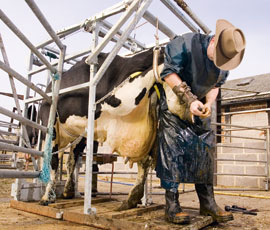New data reveals wide variation in dairying vet costs

New data showing massive variations in vet costs between UK dairy farms highlights the need for producers to reassess their approach to farm health planning, said Emma Thompson from Promar.
The findings come from data drawn from the April 2010 to March 2011 farm business accounts of 415 dairy farms up and down the country, where milk sales were measured against animal vet and medicine costs.
Variation in vet costs of £25,000 for a 150-cow herd were revealed, and in some 7,500-litre yielding herds, vet costs were found to vary between £15 and £130 a cow.
And although there was a trend towards increased vet costs with higher yields, Ms Thompson said overall yield did not dictate size of bill, and some low yielding systems had high vet bills.
She said dairy producers looking to cut down on vet medicine costs, which account for 5% of the cost of milk production, needed to ask themselves if they had a preventative or firefighting approach to animal health on their farms.
“Our main aim of releasing this data is to get farmers to look at their own data on farm, and try and figure out why and where they are spending money on vet medicine costs,” she added.
“Farmers need to look at whether they are using the vet for prevention rather than cure; prevention is always the better route.”
She said many dairy producers needed to change their attitude towards the role of the vet, and work towards using them more on a consultative basis.
“It’s about getting the vet to be a member of the farm team, not just the outsider. When he is on the farm, why not quiz him and try and get the preventative stuff coming in.”
She urged dairy producers to try and get everybody on the farm to work together as a team to prevent animal health problems, and said this could be achieved by setting clear objectives so everybody was working towards one goal.
Key pointers for dairy producers
• Prevention is cheaper than cure – routine preventative treatments such as foot trimming can save on costly treatments later on
• Change how you view the vet – is he a member of the farm team or an expensive outsider? Those farms achieving lower vet medicine costs, view the vet as a member of the team and work together towards preventing animal health problems
• Get the vet on farm more regularly – routine visits mean the vet will see more cows at one time, thus reducing the cost
• Ask yourself if you are managing your herd for health – the way the herd is managed can dictate the size of the vet bill. Small changes in management such as better groupings and more time for heat detection, can benefit animal health.
